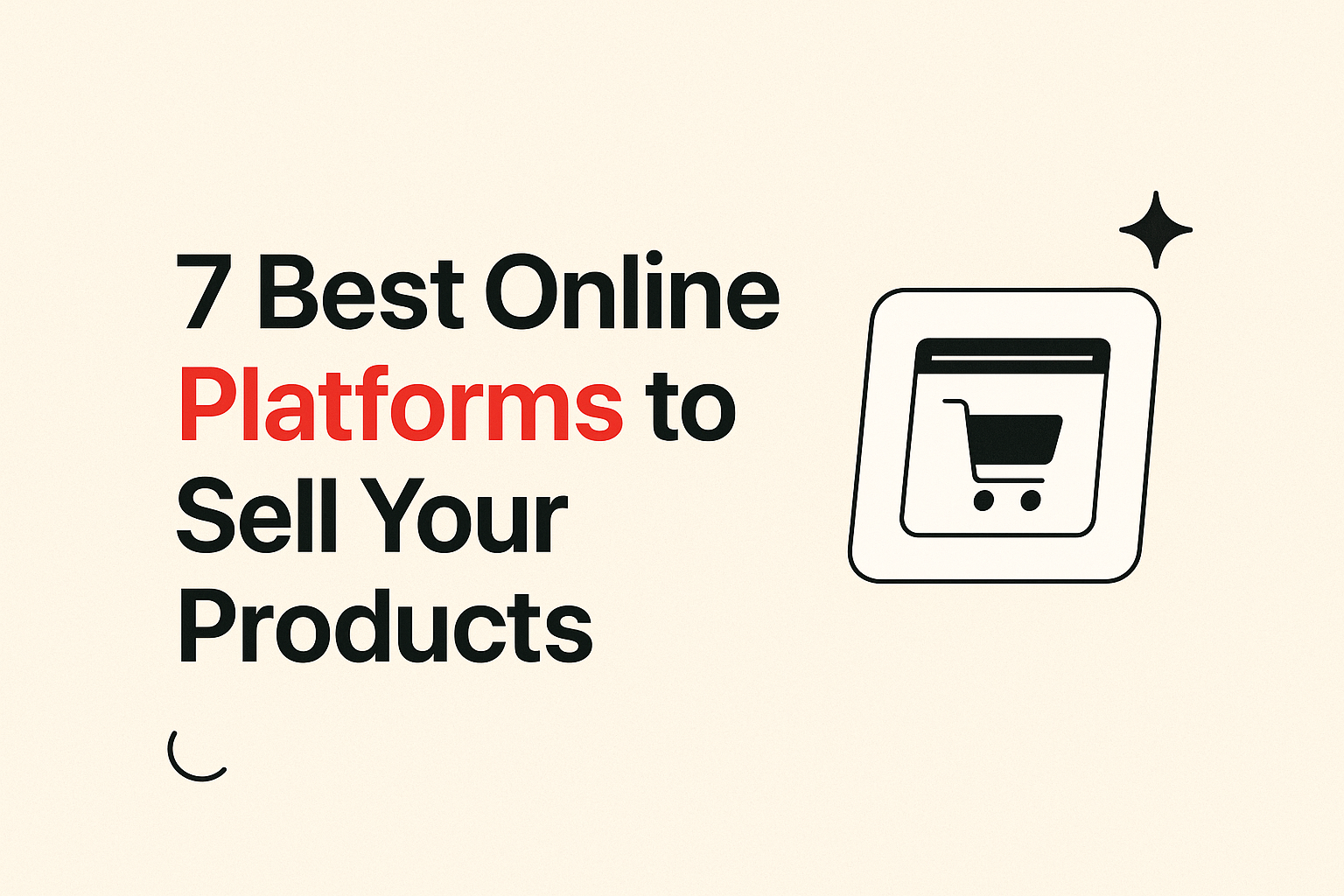Introduction
Selling products online has become one of the most profitable and scalable business models in the modern era. With global e-commerce sales projected to reach trillions of dollars in 2025, both new entrepreneurs and established businesses are moving to digital storefronts.
However, choosing the right platform can make all the difference. The ideal platform depends on your product type, budget, and target market. Some offer simplicity and speed, while others provide customization and scalability.
This article explores the seven best online platforms to sell your products in 2025 — whether you’re launching a small business or expanding a growing brand.
1. Shopify — The All-in-One E-commerce Powerhouse
Shopify remains the world’s most popular e-commerce platform for a reason. It offers everything you need to start, manage, and grow your online store — without requiring advanced technical skills.
You can choose from hundreds of templates, customize your storefront, and manage products, payments, and shipping from one dashboard. Shopify’s built-in tools for SEO, analytics, and inventory make it an ideal choice for serious entrepreneurs.
Pros:
-
User-friendly setup and professional templates
-
Seamless integration with apps and payment gateways
-
Excellent customer support and scalability
Cons:
-
Monthly fees and transaction costs
-
Limited design flexibility compared to open-source platforms
Shopify is perfect for anyone who wants a reliable, ready-to-use store that can grow over time.
2. Etsy — The Best Platform for Handmade and Creative Sellers
If your products are handmade, artistic, or vintage, Etsy is the place to be. It’s a community-driven marketplace that connects creative sellers with buyers who appreciate originality.
From jewelry and home décor to crafts and artwork, Etsy gives small creators a space to showcase their talent to a global audience.
Why sellers love Etsy:
-
Built-in audience of millions seeking unique, handcrafted items
-
Easy setup for new entrepreneurs
-
Strong reputation for authenticity and creativity
However, competition can be tough, and fees can add up over time. Standing out requires good product photography, SEO-friendly listings, and consistent customer engagement.
Etsy is ideal for artists, crafters, and small business owners who want a personalized shopping experience without handling a full-scale website.
3. Amazon — The Global Marketplace Leader
No e-commerce discussion is complete without Amazon, the world’s largest online retail platform. Selling on Amazon gives businesses instant access to a massive customer base across nearly every product category.
Amazon’s Fulfillment by Amazon (FBA) program handles storage, packaging, and delivery, making it convenient for sellers who want to scale quickly.
Advantages of selling on Amazon:
-
Global exposure and built-in customer trust
-
Fast shipping with FBA
-
High sales potential across categories
Challenges to consider:
-
Intense competition and fees
-
Limited control over branding and customer relationships
For established brands or those with mass-market products, Amazon remains one of the most powerful sales platforms in 2025.
4. eBay — Great for New, Used, and Collectible Products
eBay has evolved from an auction site into a diverse marketplace where sellers can list almost anything — from electronics and fashion to collectibles and refurbished goods.
It’s an excellent option for those looking to sell both new and pre-owned products. Sellers can choose between fixed prices or auction-style listings, giving them flexibility.
eBay works best for:
-
Resellers and small retailers
-
Sellers with unique or hard-to-find items
-
Businesses testing new products before scaling
The platform offers powerful analytics, promotional tools, and a trusted payment system through PayPal. eBay’s established reputation ensures a steady flow of customers worldwide.
5. Daraz / Flipkart — The Best Platforms for South Asian Markets
For entrepreneurs targeting the South Asian region, Daraz (in Pakistan, Bangladesh, and Sri Lanka) and Flipkart (in India) have become dominant e-commerce forces.
These platforms are designed to support both small local businesses and large brands. Sellers get the benefit of massive regional audiences and built-in logistics networks that handle deliveries and payments.
Benefits of Daraz and Flipkart:
-
Easy onboarding for local sellers
-
Cash-on-delivery options for wider reach
-
Integrated marketing and sales analytics
Tips for success:
-
Keep your inventory updated and respond quickly to customers.
-
Use platform promotions to boost visibility.
Both platforms provide an ideal gateway for businesses expanding in emerging markets.
6. Social Media Selling — Facebook, Instagram, and TikTok Shops
Social commerce is rapidly changing the way people shop. Platforms like Facebook Shops, Instagram Shopping, and TikTok Shop now allow businesses to sell directly to their followers without leaving the app.
Social selling combines e-commerce with community engagement — where customers can browse, chat, and buy in one seamless experience.
Here’s how to make the most of social media selling:
-
Use eye-catching visuals and videos to showcase your products.
-
Engage with your audience through comments and live sessions.
-
Leverage paid ads and influencer collaborations to increase visibility.
Social media stores are perfect for lifestyle brands, fashion businesses, and creators who already have an active audience. The ability to connect personally with customers gives these platforms a unique advantage.
7. Your Own Website — The Ultimate Long-Term Asset
While marketplaces are excellent for exposure, owning your own e-commerce website gives you complete control over branding, pricing, and customer relationships.
Building your own store through WordPress (WooCommerce), Shopify Plus, or BigCommerce allows you to customize the entire experience. You can optimize your site for SEO, collect emails, and create a loyal customer base independent of third-party platforms.
Advantages of having your own store:
-
Full ownership of your brand identity
-
No platform dependency or commission fees
-
Direct relationship with customers
Running your website requires some effort in marketing and maintenance, but it’s the best long-term investment for sustainable growth.
Choosing the Right Platform for Your Business
With so many options available, choosing the right platform depends on your goals, audience, and resources.
Here are key factors to consider:
-
Product Type: Handmade, digital, or retail goods.
-
Target Market: Local or global audience.
-
Budget: Subscription fees, commissions, and ads.
-
Control: How much customization and ownership you want.
If you’re just starting, begin with a ready marketplace like Etsy or Daraz. As your brand grows, build your own website for complete freedom.
E-commerce Trends Shaping 2025
The online selling landscape in 2025 is being transformed by technology and changing customer behavior.
Some major trends include:
-
AI-driven personalization improving customer experiences.
-
Voice shopping gaining popularity with smart assistants.
-
Sustainable packaging becoming a selling point for eco-conscious buyers.
-
Live shopping events increasing engagement and sales.
Staying adaptable and tech-aware ensures your business remains competitive in the evolving digital market.
Common Mistakes to Avoid When Selling Online
Even experienced sellers make errors that hurt sales and reputation. Avoid these pitfalls:
-
Using poor-quality images or vague descriptions.
-
Ignoring customer messages and reviews.
-
Overpricing products without offering value.
-
Relying on a single platform for all sales.
Successful e-commerce brands diversify, engage, and continuously improve their strategies.
Conclusion
Selling online in 2025 offers endless opportunities whether you’re launching a side hustle or running a full-time business. From Shopify’s professional tools to the community feel of Etsy and the global reach of Amazon, each platform offers unique benefits.
Start where your audience is, master one channel, and gradually expand your presence. Consistent branding, great service, and smart platform selection are the keys to long-term e-commerce success.
Your online store is more than a sales channel — it’s a digital expression of your brand. Build it with care, optimize it with strategy, and the results will follow.


